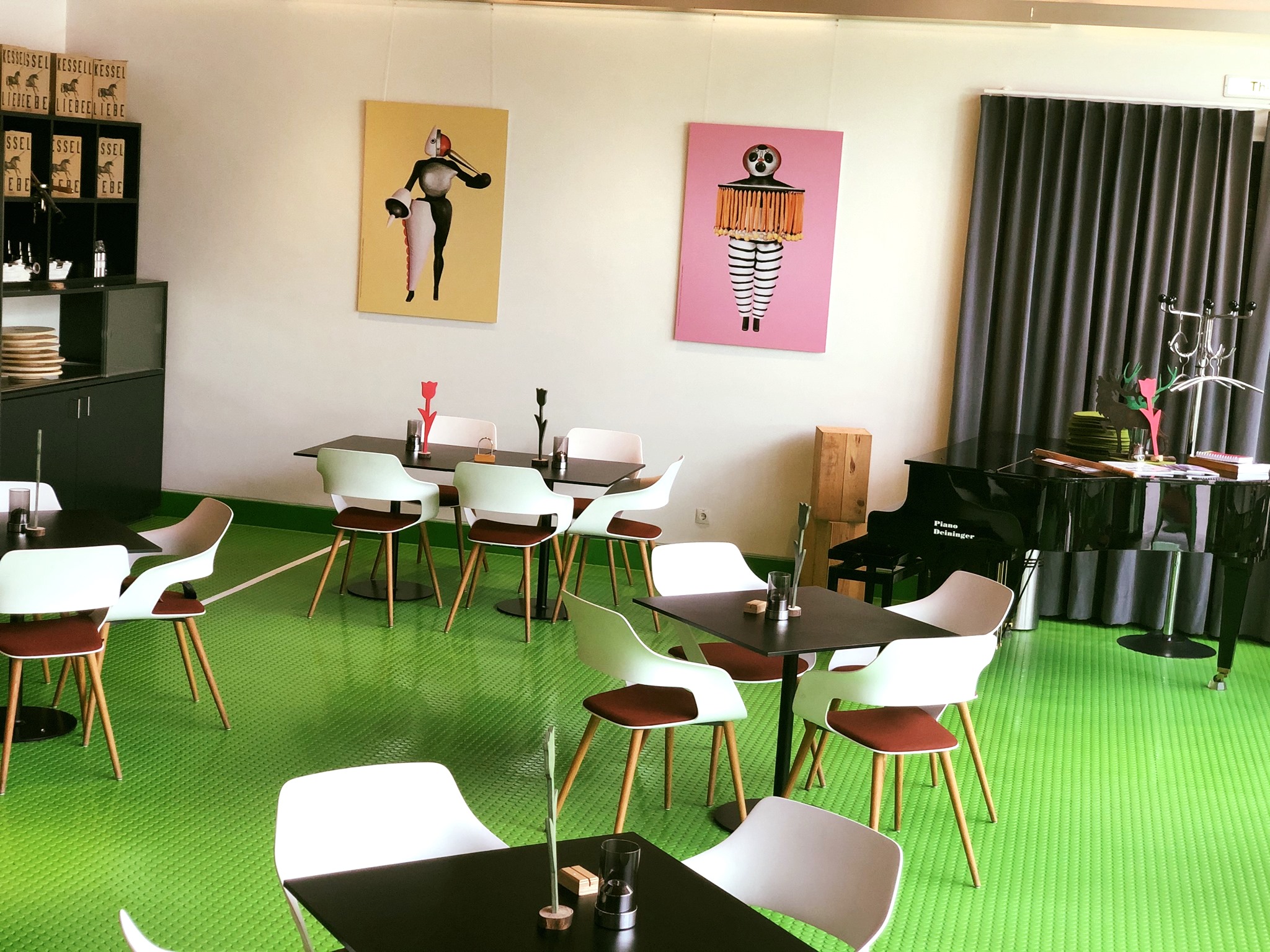1. FRESKO, STAATSGALERIE STUTTGART
Only just over an hour away by train lies a gem of a museum café in the most beautiful Billie Eilish green. It all came about back in 1984 when the extension to the Staatsgalerie Stuttgart, the Neue Staatsgalerie, was opened. Today, the building designed by James Stirling with its striking red, green, blue, and pink applications is considered one of the most important examples of Postmodernism. Here, you can not only see art, but before and after you do so you can order pasta, tabouleh or traditional Swabian “Maultaschen”: At Fresko, not only do the window struts pay homage to the colorful architecture, but the entire floor is likewise kept in the signature green of the building, which lies somewhere between apple and neon, i.e., roughly the same as the former hair color of the aforementioned pop star. After half an hour spent in the café, this has a notable impact on the retina.

FRESKO, STAATSGALERIE STUTTGART, Image via fresko-stuttgart.com
2. MITSITAM NATIVE FOODS CAFÉ, NATIONAL MUSEUM OF THE AMERICAN INDIANS, WASHINGTON D.C.
Mitsitam means “Let’s eat!” in the language of the local Indigenous population, the Delaware and the Piscataway. The museum restaurant takes the idea of the National Museum in Washington D.C. one step further, serving dishes from the Indigenous cuisines of North and South America. Here, Freddie Bitsoe, one of the best known “Native chefs” in the USA, and Richard Hetzler aspire to represent a variety of regions in culinary form. Depending on the season, the menu offers salads with wild rice or wild plants, roasted kohlrabi, corn soup, but also marinated turkey, Bolivian chili and smoked fish. Particularly well received is the hand-baked bread at Mitsitam, while the recommendation for dessert, for example, is an option made with blue corn flour.
:format(webp)/cdn.vox-cdn.com/uploads/chorus_image/image/45985474/mitsitam.0.0.jpg)
Mitsitam Native Foods Cafe, Image via www.mitsitamcafe.com
3. THE REFRESHMENT ROOMS, VICTORIA & ALBERT MUSEUM, LONDON
The oldest museum café in the world is perhaps also the most beautiful. What’s more, to top it all off, London’s Victoria & Albert Museum boasts not only one but three completely independently designed rooms that were ceremoniously opened in 1868 and have since been meticulously maintained: The Gamble Room with its luxurious décor, glittering glass, enamel and ceramic inlay was designed to evoke a fashionable Parisian coffee house or the railway station concourses of that era.
The Poynter Room, where they previously prepared and served hot dishes from a barbecue, is fitted out with blue and white tiles which, incidentally, were produced by students in a local porcelain class. And finally there is the Morris Room, designed as the name suggests by William Morris, one of the most important designers of the Victorian era, using dark blue, woodwork and motifs of flora and fauna. Although the museum now has an additional café, the thoroughly charming Refreshment Rooms are basically still open, for example for a high tea, which you can enjoy here by appointment.

The Centre Refreshment Room (later named The Gamble Room), late 1860s. Museum no. E.655-2009. © Victoria and Albert Museum, London, Image via www.vam.ac.uk
4 THE CYCLADIC CAFÉ, MUSEUM OF CYCLADIC ART, ATHEN
Entirely without any spectacular foundation, Stelios Kois and his team have transformed this museum café: Located between two parts of the building, this location within the Museum of Cycladic Art in Athens was originally decidedly unglamorous. Nor did it enjoy the spectacular views that other museums in the Greek capital boast. And yet, thanks to a recessed white structure lined all around with plants, there is a feeling of ample light and greenery.

(c) Photo Paris Tavitian, Museum of Cycladic Art, 2020, Image via cycladic.gr
5. BAR LUCE, FONDAZIONE PRADA, MAILAND
The aesthetic is unapologetic and intense. Many are sent into raptures over Wes Anderson’s unmistakable filmmaking style, which always keeps a watchful eye on every move its art department makes in addition to the direction and script. Others get a headache. But even they probably cannot help but appreciate Anderson’s art for Fondazione Prada as a successful exception to the usual museum café look. A little less saccharine than the Grand Budapest Hotel, this retro homage conjures up a fictitious era that combines elements of mid-century Modernism, Soviet pastels and trompe-l’oeil murals like a Wes Anderson movie set.

6. THE CAFÉ JACQUEMART-ANDRÉ, JACQUEMART-ANDRÉ MUSEUM, PARIS
The “most beautiful tea room in Paris”, as the museum describes its in-house café, is located in the former dining room of Édouard André and Nélie Jacquemart. The French collector couple bequeathed their art collection along with their own town mansion to the City of Paris. Masterpieces of the Renaissance, the French School and the Flemish Masters adorn the walls of not only the museum but the café, too. Visitors can enter the Café Jacquemart-André even without taking a tour of the collection. For each exhibition, a menu is created relating to the relevant theme to supplement the daily offering.

THE CAFÉ JACQUEMART-ANDRÉ, Image via www.musee-jacquemart-andre.com
7. …AND FOR THOSE STAYING AT HOME: BADIAS, SCHIRN
The café at the Schirn bears the name of its hostess: Badia Ouahi cooks what she herself most likes to eat. The cuisine combines her Moroccan roots with Israeli-Mediterranean influences and Hessen ingredients. In good weather, you can sit at the edge of the Römerberg overlooking the New Old Town and the Kunstverein, while if it’s raining or cold the beautiful café dining room boasts huge windows that were redesigned by Frankfurt-based architects Cilia and Hendrik Tovar from 2008 to 2009. Bon Appétit!
